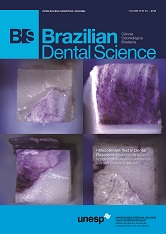Dentin hypersensitivity: Pre-hybridization as an alternative treatment
DOI:
https://doi.org/10.14295/bds.2013.v16i3.902Resumo
A hipersensibilidade dentinária pode ocorrer quando há exposição da dentina após preparos dentários para restaurações indiretas. Para evitar ou minimizar desconfortos pós-operatórios, os adesivos dentinários têm sido utilizados para proteger a dentina exposta. Esta técnica é denominada pré-hibridização. Apesar da utilização clínica, ainda existem controvérsias sobre a eficácia, o material e o protocolo mais adequado para realizá-la. Esta revisão tem como objetivo discutir os conceitos que envolvem a pré-hibridização, baseando-se nos artigos mais relevantes publicados (2002 até a data atual), indexados nas bases de dados da SciELO, MEDLINE e Pubmed. Para a pesquisa foram utilizadas as seguintes palavras-chave: pré-hibridização, hipersensibilidade dental e variáveis (ex.: pré-hibridização dentinária, hipersensibilidade dentinária, tratamento de hipersensibilidade). Foram selecionadas as referências do tipo revisão e artigos de pesquisa originais. Foram feitos esforços para identificar estudos sobre tratamentos clínicos comparativos, controlados e estudos de meta-análise sobre a hipersensibilidade e a pré-hibridização dentinária. Baseado na revisão realizada é possível destacar os adesivos autocondicionantes como a primeira escolha para os procedimentos de pré-hibridização. Porém, a literatura ainda não apresenta um protocolo consolidado e as pesquisas clínicas que estudam a eficiência desta técnica são limitadas.
Downloads
Downloads
Arquivos adicionais
Publicado
Como Citar
Edição
Seção
Licença
TRANSFERÊNCIA DE DIREITOS AUTORAIS E DECLARAÇÃO DE RESPONSABILIDADE
Toda a propriedade de direitos autorais do artigo "____________________________________________________________________" é transferido do autor(es) para a CIÊNCIA ODONTOLÓGICA BRASILEIRA, no caso do trabalho ser publicado. O artigo não foi publicado em outro lugar e não foi submetido simultaneamente para publicação em outra revista.
Vimos por meio deste, atestar que trabalho é original e não apresenta dados manipulados, fraude ou plágio. Fizemos contribuição científica significativa para o estudo e estamos cientes dos dados apresentados e de acordo com a versão final do artigo. Assumimos total responsabilidade pelos aspectos éticos do estudo.
Este texto deve ser impresso e assinado por todos os autores. A versão digitalizada deverá ser apresentada como arquivo suplementar durante o processo de submissão.




























